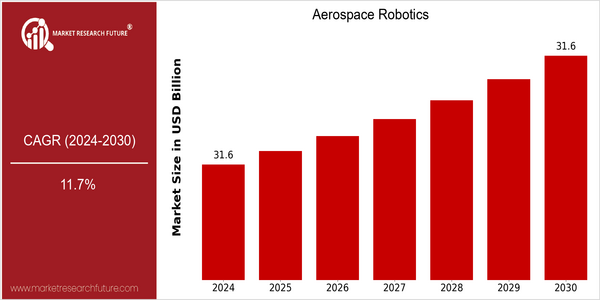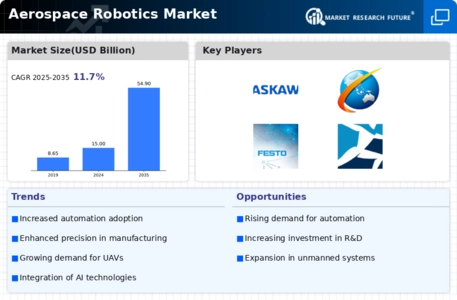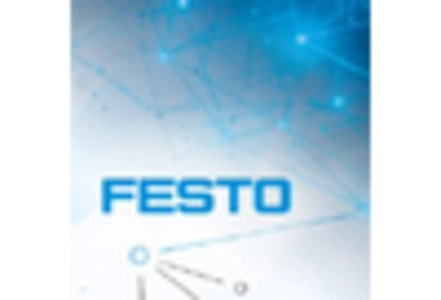-
EXECUTIVE SUMMARY 20
-
MARKET INTRODUCTION 23
-
DEFINITION 23
-
SCOPE OF THE STUDY 23
-
MARKET STRUCTURE 24
-
RESEARCH METHODOLOGY 25
-
MARKET DYNAMICS 32
-
INTRODUCTION 32
-
DRIVERS 33
- INCREASE IN GLOBAL AIRCRAFT DEMAND AND MANUFACTURING
- INCREASING USE OF ROBOTS FOR EFFICIENT AIRCRAFT PRODUCTION PROCESSES
- DRIVERS: IMPACT ANALYSIS 34
-
33
-
33
-
RESTRAINT 34
- LACK
- RESTRAINT IMPACT ANALYSIS 34
-
OF SKILLED OPERATORS 34
-
OPPORTUNITY
- HUMAN-ROBOT COLLABORATION 35
-
35
-
IMPACT OF COVID-19 35
- IMPACT ON COMPONENT MANUFACTURERS
- IMPACT ON DEVICE MANUFACTURERS 36
- COVID-19 IMPACT ON SUPPLY
-
4.5.1
-
IMPACT ON SEMICONDUCTOR MANUFACTURERS 35
-
35
-
CHAIN DELAYS 36
-
MARKET FACTOR ANALYSIS 37
-
VALUE CHAIN ANALYSIS 37
- HARDWARE OR COMPONENT MANUFACTURERS 37
- SOFTWARE DEVELOPERS 37
- SYSTEM INTEGRATORS 37
- END USERS 38
- THREATS OF NEW
- BARGAINING POWER OF SUPPLIERS 39
- THREATS OF SUBSTITUTE
- BARGAINING POWER OF BUYERS 39
- INTENSITY OF RIVALRY 39
-
ENTRANTS 38
-
39
-
GLOBAL AEROSPACE ROBOTICS MARKET, BY TYPE 40
-
OVERVIEW 40
-
6.1.1
-
GLOBAL AEROSPACE ROBOTICS MARKET, BY TYPE, 2022–2030 (USD MILLION) 41
-
6.2
-
TRADITIONAL ROBOTS 42
-
ROBOTS, 2022–2030 (USD MILLION) 42
-
42
-
6.3
-
COLLABORATIVE ROBOTS 43
-
GLOBAL AEROSPACE ROBOTICS MARKET, BY TRADITIONAL
-
ARTICULATED 42
-
PARALLEL
-
LINEAR/CARTESIAN 42
-
SCARA 43
-
OTHERS 43
-
GLOBAL AEROSPACE ROBOTICS MARKET, BY COMPONENT 44
-
OVERVIEW 44
- GLOBAL AEROSPACE ROBOTICS MARKET, BY COMPONENT, 2022–2030
-
(USD MILLION) 45
-
CONTROLLER 45
-
SENSOR 45
-
DRIVE 46
-
END EFFECTOR 46
- GLOBAL AEROSPACE ROBOTICS MARKET, BY END EFFECTORS,
- WELDING GUNS 46
- GRIPPERS
- ROBOTIC SCREWDRIVERS 47
- SANDING & DEBURRING TOOL 47
- SPECIALTY & HYBRID END EFFECTORS 47
- OTHERS 47
-
47
-
GLOBAL
-
AEROSPACE ROBOTICS MARKET, BY PAYLOAD 48
-
OVERVIEW 48
- GLOBAL
-
AEROSPACE ROBOTICS MARKET, BY PAYLOAD, 2022–2030 (USD MILLION) 49
-
8.2
-
UP TO 16.00 KG 49
-
16.01–60.00 KG 49
-
60.01–225.00 KG
-
50
-
MORE THAN 225.00 KG 50
-
GLOBAL AEROSPACE ROBOTICS MARKET, BY APPLICATION
-
51
-
OVERVIEW 51
- GLOBAL AEROSPACE ROBOTICS MARKET, BY APPLICATION,
-
DRILLING & FASTENING 52
-
NON-DESTRUCTIVE
-
TESTING & INSPECTION 52
-
WELDING & SOLDERING 53
-
SEALING
-
& DISPENSING 53
-
HANDLING 53
-
ASSEMBLING & DISASSEMBLING
-
53
-
OTHERS 53
-
GLOBAL AEROSPACE ROBOTICS MARKET, BY REGION 54
-
OVERVIEW 54
- GLOBAL AEROSPACE ROBOTICS MARKET, BY REGION, 2021
- GLOBAL AEROSPACE ROBOTICS MARKET, BY REGION,
-
VS 2030 (USD MILLION) 55
-
NORTH AMERICA 56
- NORTH AMERICA:
-
AEROSPACE ROBOTICS MARKET, BY COUNTRY, 2022–2030 (USD MILLION) 57
-
10.2.2
-
NORTH AMERICA AEROSPACE ROBOTICS MARKET, BY TYPE, 2022–2030 (USD MILLION)
-
58
-
BY COMPONENT, 2022–2030 (USD MILLION) 59
-
NORTH AMERICA AEROSPACE ROBOTICS MARKET, BY TRADITIONAL ROBOTS,
-
NORTH AMERICA AEROSPACE ROBOTICS MARKET,
-
NORTH AMERICA AEROSPACE
-
ROBOTICS MARKET, BY END EFFECTOR, 2022–2030 (USD MILLION) 60
-
NORTH
-
AMERICA AEROSPACE ROBOTICS MARKET, BY PAYLOAD, 2022–2030 (USD MILLION) 60
-
(USD MILLION) 61
-
TYPE, 2022–2030 (USD MILLION) 62
-
BY TRADITIONAL ROBOTS, 2022–2030 (USD MILLION) 62
-
NORTH AMERICA AEROSPACE ROBOTICS MARKET, BY APPLICATION, 2022–2030
-
US 62
-
US AEROSPACE ROBOTICS MARKET, BY
-
US AEROSPACE ROBOTICS MARKET,
-
US AEROSPACE
-
ROBOTICS MARKET, BY COMPONENT, 2022–2030 (USD MILLION) 62
-
10.2.6.2.1
-
US AEROSPACE ROBOTICS MARKET, BY END EFFECTOR, 2022–2030 (USD MILLION) 63
-
63
-
MILLION) 63
-
BY TYPE, 2022–2030 (USD MILLION) 64
-
US AEROSPACE ROBOTICS MARKET, BY PAYLOAD, 2022–2030 (USD MILLION)
-
US AEROSPACE ROBOTICS MARKET, BY APPLICATION, 2022–2030 (USD
-
CANADA 64
-
CANADA AEROSPACE ROBOTICS MARKET,
-
CANADA AEROSPACE ROBOTICS
-
MARKET, BY TRADITIONAL ROBOTS, 2022–2030 (USD MILLION) 64
-
CANADA
-
AEROSPACE ROBOTICS MARKET, BY COMPONENT, 2022–2030 (USD MILLION) 64
-
10.2.7.2.1
-
CANADA AEROSPACE ROBOTICS MARKET, BY END EFFECTOR, 2022–2030 (USD MILLION)
-
65
-
MILLION) 65
-
(USD MILLION) 65
-
BY TYPE, 2022–2030 (USD MILLION) 66
-
CANADA AEROSPACE ROBOTICS MARKET, BY PAYLOAD, 2022–2030 (USD
-
CANADA AEROSPACE ROBOTICS MARKET, BY APPLICATION, 2022–2030
-
MEXICO 66
-
MEXICO AEROSPACE ROBOTICS MARKET,
-
MEXICO AEROSPACE ROBOTICS
-
MARKET, BY TRADITIONAL ROBOTS, 2022–2030 (USD MILLION) 66
-
MEXICO
-
AEROSPACE ROBOTICS MARKET, BY COMPONENT, 2022–2030 (USD MILLION) 66
-
10.2.8.2.1
-
MEXICO AEROSPACE ROBOTICS MARKET, BY END EFFECTOR, 2022–2030 (USD MILLION)
-
67
-
MILLION) 67
-
(USD MILLION) 67
-
BY COUNTRY, 2022–2030 (USD MILLION) 69
-
MEXICO AEROSPACE ROBOTICS MARKET, BY PAYLOAD, 2022–2030 (USD
-
MEXICO AEROSPACE ROBOTICS MARKET, BY APPLICATION, 2022–2030
-
EUROPE 68
- EUROPE: AEROSPACE ROBOTICS MARKET,
- EUROPE AEROSPACE ROBOTICS
-
MARKET, BY TYPE, 2022–2030 (USD MILLION) 70
-
EUROPE AEROSPACE
-
ROBOTICS MARKET, BY TRADITIONAL ROBOTS, 2022–2030 (USD MILLION) 70
-
10.3.3
-
EUROPE AEROSPACE ROBOTICS MARKET, BY COMPONENT, 2022–2030 (USD MILLION) 71
-
MILLION) 71
-
(USD MILLION) 72
-
(USD MILLION) 73
-
EUROPE AEROSPACE ROBOTICS MARKET, BY END EFFECTOR, 2022–2030 (USD
-
EUROPE AEROSPACE ROBOTICS MARKET, BY PAYLOAD, 2022–2030
-
EUROPE AEROSPACE ROBOTICS MARKET, BY APPLICATION, 2022–2030
-
GERMANY 74
-
GERMANY AEROSPACE ROBOTICS
-
MARKET, BY TYPE, 2022–2030 (USD MILLION) 74
-
GERMANY AEROSPACE
-
ROBOTICS MARKET, BY TRADITIONAL ROBOTS, 2022–2030 (USD MILLION) 74
-
10.3.6.2
-
GERMANY AEROSPACE ROBOTICS MARKET, BY COMPONENT, 2022–2030 (USD MILLION) 74
-
(USD MILLION) 75
-
(USD MILLION) 75
-
GERMANY AEROSPACE ROBOTICS MARKET, BY END EFFECTOR, 2022–2030
-
GERMANY AEROSPACE ROBOTICS MARKET, BY PAYLOAD, 2022–2030
-
GERMANY AEROSPACE ROBOTICS MARKET, BY APPLICATION,
-
UK 76
-
UK AEROSPACE ROBOTICS
-
MARKET, BY TYPE, 2022–2030 (USD MILLION) 76
-
UK AEROSPACE ROBOTICS
-
MARKET, BY TRADITIONAL ROBOTS, 2022–2030 (USD MILLION) 76
-
UK
-
AEROSPACE ROBOTICS MARKET, BY COMPONENT, 2022–2030 (USD MILLION) 76
-
10.3.7.2.1
-
UK AEROSPACE ROBOTICS MARKET, BY END EFFECTOR, 2022–2030 (USD MILLION) 77
-
77
-
MILLION) 77
-
BY TYPE, 2022–2030 (USD MILLION) 78
-
UK AEROSPACE ROBOTICS MARKET, BY PAYLOAD, 2022–2030 (USD MILLION)
-
UK AEROSPACE ROBOTICS MARKET, BY APPLICATION, 2022–2030 (USD
-
FRANCE 78
-
FRANCE AEROSPACE ROBOTICS MARKET,
-
FRANCE AEROSPACE ROBOTICS
-
MARKET, BY TRADITIONAL ROBOTS, 2022–2030 (USD MILLION) 78
-
FRANCE
-
AEROSPACE ROBOTICS MARKET, BY COMPONENT, 2022–2030 (USD MILLION) 78
-
10.3.8.2.1
-
FRANCE AEROSPACE ROBOTICS MARKET, BY END EFFECTOR, 2022–2030 (USD MILLION)
-
79
-
MILLION) 79
-
(USD MILLION) 79
-
BY TYPE, 2022–2030 (USD MILLION) 80
-
FRANCE AEROSPACE ROBOTICS MARKET, BY PAYLOAD, 2022–2030 (USD
-
FRANCE AEROSPACE ROBOTICS MARKET, BY APPLICATION, 2022–2030
-
ITALY 80
-
ITALY AEROSPACE ROBOTICS MARKET,
-
ITALY AEROSPACE ROBOTICS
-
MARKET, BY TRADITIONAL ROBOTS, 2022–2030 (USD MILLION) 80
-
-
10.3.9.2
-
ITALY AEROSPACE ROBOTICS MARKET, BY COMPONENT, 2022–2030 (USD MILLION) 80
-
MILLION) 81
-
(USD MILLION) 81
-
ITALY AEROSPACE ROBOTICS MARKET, BY END EFFECTOR, 2022–2030 (USD
-
ITALY AEROSPACE ROBOTICS MARKET, BY PAYLOAD, 2022–2030
-
ITALY AEROSPACE ROBOTICS MARKET, BY APPLICATION,
-
SPAIN 82
-
SPAIN AEROSPACE
-
ROBOTICS MARKET, BY TYPE, 2022–2030 (USD MILLION) 82
-
SPAIN
-
AEROSPACE ROBOTICS MARKET, BY TRADITIONAL ROBOTS, 2022–2030 (USD MILLION)
-
82
-
(USD MILLION) 82
-
BY PAYLOAD, 2022–2030 (USD MILLION) 83
-
SPAIN AEROSPACE ROBOTICS MARKET, BY COMPONENT, 2022–2030
-
SPAIN AEROSPACE ROBOTICS MARKET, BY END EFFECTOR,
-
SPAIN AEROSPACE ROBOTICS MARKET,
-
SPAIN AEROSPACE ROBOTICS
-
MARKET, BY APPLICATION, 2022–2030 (USD MILLION) 83
-
84
-
(USD MILLION) 84
-
ROBOTS,
-
REST OF EUROPE
-
REST OF EUROPE AEROSPACE ROBOTICS MARKET, BY TYPE, 2022–2030
-
REST OF EUROPE AEROSPACE ROBOTICS MARKET, BY TRADITIONAL
-
REST OF EUROPE AEROSPACE
-
ROBOTICS MARKET, BY COMPONENT, 2022–2030 (USD MILLION) 84
-
10.3.11.2.1
-
REST OF EUROPE AEROSPACE ROBOTICS MARKET, BY END EFFECTOR, 2022–2030 (USD
-
MILLION) 85
-
REST OF EUROPE AEROSPACE ROBOTICS MARKET, BY PAYLOAD,
-
REST OF EUROPE AEROSPACE ROBOTICS
-
MARKET, BY APPLICATION, 2022–2030 (USD MILLION) 86
-
ASIA-PACIFIC
- ASIA-PACIFIC: AEROSPACE ROBOTICS MARKET, BY COUNTRY, 2022–2030
- ASIA-PACIFIC AEROSPACE ROBOTICS MARKET, BY TYPE, 2022–2030
- ASIA-PACIFIC AEROSPACE ROBOTICS
-
87
-
(USD MILLION) 88
-
(USD MILLION) 89
-
ROBOTS, 2022–2030 (USD MILLION) 89
-
MARKET, BY COMPONENT, 2022–2030 (USD MILLION) 90
-
ASIA-PACIFIC
-
AEROSPACE ROBOTICS MARKET, BY END EFFECTOR, 2022–2030 (USD MILLION) 90
-
MILLION) 91
-
ASIA-PACIFIC AEROSPACE ROBOTICS MARKET, BY PAYLOAD, 2022–2030 (USD
-
ASIA-PACIFIC AEROSPACE ROBOTICS MARKET, BY APPLICATION,
-
CHINA 93
-
CHINA AEROSPACE
-
ROBOTICS MARKET, BY TYPE, 2022–2030 (USD MILLION) 93
-
CHINA
-
AEROSPACE ROBOTICS MARKET, BY TRADITIONAL ROBOTS, 2022–2030 (USD MILLION)
-
93
-
(USD MILLION) 93
-
BY PAYLOAD, 2022–2030 (USD MILLION) 94
-
CHINA AEROSPACE ROBOTICS MARKET, BY COMPONENT, 2022–2030
-
CHINA AEROSPACE ROBOTICS MARKET, BY END EFFECTOR,
-
CHINA AEROSPACE ROBOTICS MARKET,
-
CHINA AEROSPACE ROBOTICS
-
MARKET, BY APPLICATION, 2022–2030 (USD MILLION) 94
-
-
10.4.7
-
JAPAN 95
-
(USD MILLION) 95
-
ROBOTS, 2022–2030 (USD MILLION) 95
-
JAPAN AEROSPACE ROBOTICS MARKET, BY TYPE, 2022–2030
-
JAPAN AEROSPACE ROBOTICS MARKET, BY TRADITIONAL
-
JAPAN AEROSPACE ROBOTICS
-
MARKET, BY COMPONENT, 2022–2030 (USD MILLION) 95
-
JAPAN AEROSPACE
-
ROBOTICS MARKET, BY END EFFECTOR, 2022–2030 (USD MILLION) 96
-
10.4.7.3
-
JAPAN AEROSPACE ROBOTICS MARKET, BY PAYLOAD, 2022–2030 (USD MILLION) 96
-
MILLION) 96
-
BY TYPE, 2022–2030 (USD MILLION) 97
-
JAPAN AEROSPACE ROBOTICS MARKET, BY APPLICATION, 2022–2030 (USD
-
INDIA 97
-
INDIA AEROSPACE ROBOTICS MARKET,
-
INDIA AEROSPACE ROBOTICS
-
MARKET, BY TRADITIONAL ROBOTS, 2022–2030 (USD MILLION) 97
-
INDIA
-
AEROSPACE ROBOTICS MARKET, BY COMPONENT, 2022–2030 (USD MILLION) 97
-
10.4.8.2.1
-
INDIA AEROSPACE ROBOTICS MARKET, BY END EFFECTOR, 2022–2030 (USD MILLION)
-
98
-
MILLION) 98
-
(USD MILLION) 98
-
INDIA AEROSPACE ROBOTICS MARKET, BY PAYLOAD, 2022–2030 (USD
-
INDIA AEROSPACE ROBOTICS MARKET, BY APPLICATION, 2022–2030
-
SOUTH KOREA 99
-
SOUTH KOREA AEROSPACE
-
ROBOTICS MARKET, BY TYPE, 2022–2030 (USD MILLION) 99
-
SOUTH
-
KOREA AEROSPACE ROBOTICS MARKET, BY TRADITIONAL ROBOTS, 2022–2030
-
(USD
-
MILLION) 99
-
(USD MILLION) 99
-
BY PAYLOAD, 2022–2030 (USD MILLION) 100
-
SOUTH KOREA AEROSPACE ROBOTICS MARKET, BY COMPONENT, 2022–2030
-
SOUTH KOREA AEROSPACE ROBOTICS MARKET, BY END EFFECTOR,
-
SOUTH KOREA AEROSPACE ROBOTICS MARKET,
-
SOUTH KOREA AEROSPACE
-
ROBOTICS MARKET, BY APPLICATION, 2022–2030 (USD MILLION) 100
-
10.4.10
-
REST OF ASIA-PACIFIC 101
-
REST OF ASIA-PACIFIC AEROSPACE ROBOTICS
-
MARKET, BY TYPE, 2022–2030 (USD MILLION) 101
-
REST OF ASIA-PACIFIC
-
AEROSPACE ROBOTICS MARKET, BY TRADITIONAL ROBOTS,
-
101
-
REST OF ASIA-PACIFIC AEROSPACE ROBOTICS MARKET, BY COMPONENT,
-
REST OF ASIA-PACIFIC AEROSPACE
-
ROBOTICS MARKET, BY END EFFECTOR, 2022–2030
-
(USD MILLION) 102
-
10.4.10.3
-
REST OF ASIA-PACIFIC AEROSPACE ROBOTICS MARKET, BY PAYLOAD, 2022–2030 (USD
-
MILLION) 102
-
10.5.1
-
REST OF ASIA-PACIFIC AEROSPACE ROBOTICS MARKET, BY APPLICATION,
-
MIDDLE EAST & AFRICA 103
-
MIDDLE EAST & AFRICA AEROSPACE ROBOTICS MARKET, BY TYPE, 2022–2030 (USD
-
MILLION) 104
-
TRADITIONAL ROBOTS, 2022–
-
(USD MILLION) 104
-
-
MIDDLE EAST & AFRICA AEROSPACE ROBOTICS MARKET, BY
-
MIDDLE
-
EAST & AFRICA AEROSPACE ROBOTICS MARKET, BY COMPONENT, 2022–2030 (USD
-
MILLION) 105
-
END EFFECTOR, 2022–2030 (USD MILLION) 106
-
MIDDLE EAST & AFRICA AEROSPACE ROBOTICS MARKET, BY
-
MIDDLE EAST & AFRICA
-
AEROSPACE ROBOTICS MARKET, BY PAYLOAD, 2022–2030 (USD MILLION) 106
-
10.5.4
-
MIDDLE EAST & AFRICA AEROSPACE ROBOTICS MARKET, BY APPLICATION, 2022–2030
-
(USD MILLION) 107
-
SOUTH AMERICA 108
- SOUTH AMERICA AEROSPACE
-
ROBOTICS MARKET, BY TYPE, 2022–2030 (USD MILLION) 108
-
SOUTH
-
AMERICA AEROSPACE ROBOTICS MARKET, BY TRADITIONAL ROBOTS, 2022–2030 (USD MILLION)
-
109
-
(USD MILLION) 109
-
EFFECTOR, 2022–2030 (USD MILLION) 110
-
SOUTH AMERICA AEROSPACE ROBOTICS MARKET, BY COMPONENT, 2022–2030
-
SOUTH AMERICA AEROSPACE ROBOTICS MARKET, BY END
-
SOUTH AMERICA AEROSPACE
-
ROBOTICS MARKET, BY PAYLOAD, 2022–2030 (USD MILLION) 110
-
SOUTH
-
AMERICA AEROSPACE ROBOTICS MARKET, BY APPLICATION, 2022–2030 (USD MILLION)
-
111
-
COMPETITVE LANDSCAPE 112
-
COMPETITIVE BENCHMARKING 113
-
11.2
-
VENDOR SHARE ANALYSIS 114
-
RECENT DEVELOPMENTS 114
- PRODUCT
- PARTNERSHIPS/AGREEMENTS/CONTRACTS/COLLABORATIONS 116
-
DEVELOPMENT 114
-
COMPANY PROFILES 119
-
KUKA AG 119
- COMPANY OVERVIEW 119
- FINANCIAL OVERVIEW 120
- PRODUCTS/SOLUTIONS/SERVICES OFFERED
- KEY DEVELOPMENTS 122
- SWOT ANALYSIS 122
- KEY
-
121
-
STRATEGIES 123
-
ABB GROUP 124
- COMPANY OVERVIEW 124
- PRODUCTS/SOLUTIONS/SERVICES OFFERED 126
- SWOT ANALYSIS 127
- KEY STRATEGIES 127
-
12.2.2
-
FINANCIAL OVERVIEW 125
-
12.2.4
-
KEY DEVELOPMENTS 126
-
FANUC CORPORATION 128
- COMPANY OVERVIEW 128
- FINANCIAL
- PRODUCTS/SOLUTIONS/SERVICES OFFERED 129
- KEY
- SWOT ANALYSIS 131
- KEY STRATEGIES 131
-
OVERVIEW 129
-
DEVELOPMENTS 130
-
YASKAWA ELECTRIC CORPORATION 132
- COMPANY OVERVIEW 132
- PRODUCTS/SERVICES OFFERED 133
- KEY
- SWOT ANALYSIS 134
- KEY STRATEGIES 135
-
12.4.2
-
FINANCIAL OVERVIEW 133
-
DEVELOPMENTS 134
-
KAWASAKI HEAVY INDUSTRIES, LTD 136
- COMPANY OVERVIEW 136
- PRODUCTS/SERVICES OFFERED 137
- KEY
- SWOT ANALYSIS 140
- KEY STRATEGIES 140
-
12.5.2
-
FINANCIAL OVERVIEW 137
-
DEVELOPMENTS 139
-
MTORRES 141
- COMPANY OVERVIEW 141
- FINANCIAL OVERVIEW
- PRODUCTS/SERVICES OFFERED 141
- KEY DEVELOPMENTS 142
-
141
-
OC ROBOTICS 143
- COMPANY OVERVIEW 143
- FINANCIAL OVERVIEW
- PRODUCTS/SERVICES OFFERED 144
- KEY DEVELOPMENTS 145
- SWOT ANALYSIS 145
- KEY STRATEGIES 145
-
144
-
GÜDEL GROUP
- COMPANY OVERVIEW 146
- FINANCIAL OVERVIEW 146
- KEY DEVELOPMENTS 147
-
AG 146
-
12.8.3
-
PRODUCTS/SOLUTIONS/SERVICES OFFERED 146
-
12.8.5
-
KEY STRATEGIES 147
-
-
ELECTROIMPACT INC. 148
- COMPANY
- FINANCIAL OVERVIEW 148
- PRODUCTS/SOLUTIONS/SERVICES
- KEY DEVELOPMENTS 149
-
OVERVIEW 148
-
OFFERED 148
-
UNIVERSAL ROBOTS A/S 150
- COMPANY OVERVIEW 150
- FINANCIAL OVERVIEW 150
- KEY DEVELOPMENTS 150
- KEY STRATEGIES 151
-
12.10.3
-
PRODUCTS/SOLUTIONS/SERVICES OFFERED 150
-
12.10.5
-
SWOT ANALYSIS 151
-
STÄUBLI 152
- COMPANY OVERVIEW 152
- FINANCIAL OVERVIEW 152
- KEY DEVELOPMENTS 153
-
12.11.3
-
PRODUCTS/SOLUTIONS/SERVICES OFFERED 152
-
12.11.5
-
KEY STRATEGIES 153
-
COMAU 154
- COMPANY OVERVIEW 154
- PRODUCTS/SOLUTIONS/SERVICES OFFERED 154
- KEY STRATEGIES 156
-
12.12.2
-
FINANCIAL OVERVIEW 154
-
12.12.4
-
KEY DEVELOPMENTS 156
-
FESTO INC. 157
- COMPANY OVERVIEW 157
- FINANCIAL OVERVIEW 157
- KEY DEVELOPMENTS 158
-
12.13.3
-
PRODUCTS/SOLUTIONS/SERVICES OFFERED 157
-
12.13.5
-
KEY STRATEGIES 158
-
BOSTON DYNAMICS 159
- COMPANY OVERVIEW
- FINANCIAL OVERVIEW 160
- PRODUCTS/SOLUTIONS/SERVICES
- KEY DEVELOPMENTS 161
- SWOT ANALYSIS 162
- KEY STRATEGIES 162
-
159
-
OFFERED 161
-
-
LIST OF TABLES
-
GLOBAL
-
AEROSPACE ROBOTICS MARKET, BY TYPE, 2022–2030 (USD MILLION) 41
-
TABLE
-
GLOBAL AEROSPACE ROBOTICS MARKET, BY TRADITIONAL ROBOTS, 2022–2030 (USD
-
MILLION) 42
-
GLOBAL AEROSPACE ROBOTICS MARKET, BY COMPONENT, 2022–2030
-
(USD MILLION) 45
-
GLOBAL AEROSPACE ROBOTICS MARKET, BY END EFFECTORS,
-
GLOBAL AEROSPACE ROBOTICS MARKET,
-
BY PAYLOAD, 2022–2030 (USD MILLION) 49
-
GLOBAL AEROSPACE ROBOTICS
-
MARKET, BY APPLICATION, 2022–2030 (USD MILLION) 52
-
GLOBAL AEROSPACE
-
ROBOTICS MARKET, BY REGION, 2022–2030 (USD MILLION) 55
-
NORTH
-
AMERICA AEROSPACE ROBOTICS MARKET, BY COUNTRY, 2022–2030 (USD MILLION) 57
-
NORTH AMERICA AEROSPACE ROBOTICS MARKET, BY TYPE, 2022–2030 (USD
-
MILLION) 58
-
NORTH AMERICA AEROSPACE ROBOTICS MARKET, BY TRADITIONAL
-
ROBOTS, 2022–2030 (USD MILLION) 58
-
NORTH AMERICA AEROSPACE ROBOTICS
-
MARKET, BY COMPONENT, 2022–2030 (USD MILLION) 59
-
NORTH AMERICA
-
AEROSPACE ROBOTICS MARKET, BY END EFFECTOR, 2022–2030 (USD MILLION) 60
-
NORTH AMERICA AEROSPACE ROBOTICS MARKET, BY PAYLOAD, 2022–2030
-
(USD MILLION) 60
-
NORTH AMERICA AEROSPACE ROBOTICS MARKET, BY APPLICATION,
-
US AEROSPACE ROBOTICS MARKET, BY
-
TYPE, 2022–2030 (USD MILLION) 62
-
US AEROSPACE ROBOTICS MARKET,
-
BY TRADITIONAL ROBOTS, 2022–2030 (USD MILLION) 62
-
US AEROSPACE
-
ROBOTICS MARKET, BY COMPONENT, 2022–2030 (USD MILLION) 62
-
US
-
AEROSPACE ROBOTICS MARKET, BY END EFFECTOR, 2022–2030 (USD MILLION) 63
-
US AEROSPACE ROBOTICS MARKET, BY PAYLOAD, 2022–2030 (USD MILLION)
-
63
-
US AEROSPACE ROBOTICS MARKET, BY APPLICATION, 2022–2030 (USD
-
MILLION) 63
-
CANADA AEROSPACE ROBOTICS MARKET, BY TYPE, 2022–2030
-
(USD MILLION) 64
-
CANADA AEROSPACE ROBOTICS MARKET, BY TRADITIONAL
-
ROBOTS, 2022–2030 (USD MILLION) 64
-
CANADA AEROSPACE ROBOTICS
-
MARKET, BY COMPONENT, 2022–2030 (USD MILLION) 64
-
CANADA AEROSPACE
-
ROBOTICS MARKET, BY END EFFECTOR, 2022–2030 (USD MILLION) 65
-
TABLE 25
-
CANADA AEROSPACE ROBOTICS MARKET, BY PAYLOAD, 2022–2030 (USD MILLION) 65
-
CANADA AEROSPACE ROBOTICS MARKET, BY APPLICATION, 2022–2030 (USD
-
MILLION) 65
-
MEXICO AEROSPACE ROBOTICS MARKET, BY TYPE, 2022–2030
-
(USD MILLION) 66
-
MEXICO AEROSPACE ROBOTICS MARKET, BY TRADITIONAL
-
ROBOTS, 2022–2030 (USD MILLION) 66
-
MEXICO AEROSPACE ROBOTICS
-
MARKET, BY COMPONENT, 2022–2030 (USD MILLION) 66
-
MEXICO AEROSPACE
-
ROBOTICS MARKET, BY END EFFECTOR, 2022–2030 (USD MILLION) 67
-
TABLE 31
-
MEXICO AEROSPACE ROBOTICS MARKET, BY PAYLOAD, 2022–2030 (USD MILLION) 67
-
MEXICO AEROSPACE ROBOTICS MARKET, BY APPLICATION, 2022–2030 (USD
-
MILLION) 67
-
EUROPE AEROSPACE ROBOTICS MARKET, BY COUNTRY, 2022–2030
-
(USD MILLION) 69
-
EUROPE AEROSPACE ROBOTICS MARKET, BY TYPE, 2022–2030
-
(USD MILLION) 70
-
EUROPE AEROSPACE ROBOTICS MARKET, BY TRADITIONAL
-
ROBOTS, 2022–2030 (USD MILLION) 70
-
EUROPE AEROSPACE ROBOTICS
-
MARKET, BY COMPONENT, 2022–2030 (USD MILLION) 71
-
EUROPE AEROSPACE
-
ROBOTICS MARKET, BY END EFFECTOR, 2022–2030 (USD MILLION) 71
-
TABLE 38
-
EUROPE AEROSPACE ROBOTICS MARKET, BY PAYLOAD, 2022–2030 (USD MILLION) 72
-
EUROPE AEROSPACE ROBOTICS MARKET, BY APPLICATION, 2022–2030 (USD
-
MILLION) 73
-
GERMANY AEROSPACE ROBOTICS MARKET, BY TYPE, 2022–2030
-
(USD MILLION) 74
-
GERMANY AEROSPACE ROBOTICS MARKET, BY TRADITIONAL
-
ROBOTS, 2022–2030 (USD MILLION) 74
-
GERMANY AEROSPACE ROBOTICS
-
MARKET, BY COMPONENT, 2022–2030 (USD MILLION) 74
-
GERMANY AEROSPACE
-
ROBOTICS MARKET, BY END EFFECTOR, 2022–2030 (USD MILLION) 75
-
TABLE 44
-
GERMANY AEROSPACE ROBOTICS MARKET, BY PAYLOAD, 2022–2030 (USD MILLION) 75
-
GERMANY AEROSPACE ROBOTICS MARKET, BY APPLICATION, 2022–2030 (USD
-
MILLION) 75
-
UK AEROSPACE ROBOTICS MARKET, BY TYPE, 2022–2030
-
(USD MILLION) 76
-
UK AEROSPACE ROBOTICS MARKET, BY TRADITIONAL ROBOTS,
-
UK AEROSPACE ROBOTICS MARKET, BY
-
COMPONENT, 2022–2030 (USD MILLION) 76
-
UK AEROSPACE ROBOTICS
-
MARKET, BY END EFFECTOR, 2022–2030 (USD MILLION) 77
-
UK AEROSPACE
-
ROBOTICS MARKET, BY PAYLOAD, 2022–2030 (USD MILLION) 77
-
UK AEROSPACE
-
ROBOTICS MARKET, BY APPLICATION, 2022–2030 (USD MILLION) 77
-
TABLE 52
-
FRANCE AEROSPACE ROBOTICS MARKET, BY TYPE, 2022–2030 (USD MILLION) 78
-
TABLE
-
FRANCE AEROSPACE ROBOTICS MARKET, BY TRADITIONAL ROBOTS, 2022–2030 (USD
-
MILLION) 78
-
FRANCE AEROSPACE ROBOTICS MARKET, BY COMPONENT, 2022–2030
-
(USD MILLION) 78
-
FRANCE AEROSPACE ROBOTICS MARKET, BY END EFFECTOR,
-
FRANCE AEROSPACE ROBOTICS MARKET,
-
BY PAYLOAD, 2022–2030 (USD MILLION) 79
-
FRANCE AEROSPACE ROBOTICS
-
MARKET, BY APPLICATION, 2022–2030 (USD MILLION) 79
-
ITALY AEROSPACE
-
ROBOTICS MARKET, BY TYPE, 2022–2030 (USD MILLION) 80
-
ITALY AEROSPACE
-
ROBOTICS MARKET, BY TRADITIONAL ROBOTS, 2022–2030 (USD MILLION) 80
-
TABLE
-
ITALY AEROSPACE ROBOTICS MARKET, BY COMPONENT, 2022–2030 (USD MILLION)
-
80
-
ITALY AEROSPACE ROBOTICS MARKET, BY END EFFECTOR, 2022–2030
-
(USD MILLION) 81
-
ITALY AEROSPACE ROBOTICS MARKET, BY PAYLOAD, 2022–2030
-
(USD MILLION) 81
-
ITALY AEROSPACE ROBOTICS MARKET, BY APPLICATION,
-
SPAIN AEROSPACE ROBOTICS MARKET,
-
BY TYPE, 2022–2030 (USD MILLION) 82
-
SPAIN AEROSPACE ROBOTICS
-
MARKET, BY TRADITIONAL ROBOTS, 2022–2030 (USD MILLION) 82
-
SPAIN
-
AEROSPACE ROBOTICS MARKET, BY COMPONENT, 2022–2030 (USD MILLION) 82
-
TABLE
-
SPAIN AEROSPACE ROBOTICS MARKET, BY END EFFECTOR, 2022–2030 (USD MILLION)
-
83
-
SPAIN AEROSPACE ROBOTICS MARKET, BY PAYLOAD, 2022–2030 (USD
-
MILLION) 83
-
SPAIN AEROSPACE ROBOTICS MARKET, BY APPLICATION, 2022–2030
-
(USD MILLION) 83
-
REST OF EUROPE AEROSPACE ROBOTICS MARKET, BY TYPE,
-
REST OF EUROPE AEROSPACE ROBOTICS
-
MARKET, BY TRADITIONAL ROBOTS, 2022–2030 (USD MILLION) 84
-
REST
-
OF EUROPE AEROSPACE ROBOTICS MARKET, BY COMPONENT, 2022–2030 (USD MILLION)
-
84
-
REST OF EUROPE AEROSPACE ROBOTICS MARKET, BY END EFFECTOR, 2022–2030
-
(USD MILLION) 85
-
REST OF EUROPE AEROSPACE ROBOTICS MARKET, BY PAYLOAD,
-
REST OF EUROPE AEROSPACE ROBOTICS
-
MARKET, BY APPLICATION, 2022–2030 (USD MILLION) 86
-
ASIA-PACIFIC
-
AEROSPACE ROBOTICS MARKET, BY COUNTRY, 2022–2030 (USD MILLION) 88
-
TABLE
-
ASIA-PACIFIC AEROSPACE ROBOTICS MARKET, BY TYPE, 2022–2030 (USD MILLION)
-
89
-
ASIA-PACIFIC AEROSPACE ROBOTICS MARKET, BY TRADITIONAL ROBOTS,
-
ASIA-PACIFIC AEROSPACE ROBOTICS MARKET,
-
BY COMPONENT, 2022–2030 (USD MILLION) 90
-
ASIA-PACIFIC AEROSPACE
-
ROBOTICS MARKET, BY END EFFECTOR, 2022–2030 (USD MILLION) 90
-
TABLE 81
-
ASIA-PACIFIC AEROSPACE ROBOTICS MARKET, BY PAYLOAD, 2022–2030 (USD MILLION)
-
91
-
ASIA-PACIFIC AEROSPACE ROBOTICS MARKET, BY APPLICATION, 2022–2030
-
(USD MILLION) 92
-
CHINA AEROSPACE ROBOTICS MARKET, BY TYPE, 2022–2030
-
(USD MILLION) 93
-
CHINA AEROSPACE ROBOTICS MARKET, BY TRADITIONAL ROBOTS,
-
CHINA AEROSPACE ROBOTICS MARKET,
-
BY COMPONENT, 2022–2030 (USD MILLION) 93
-
CHINA AEROSPACE ROBOTICS
-
MARKET, BY END EFFECTOR, 2022–2030 (USD MILLION) 94
-
CHINA AEROSPACE
-
ROBOTICS MARKET, BY PAYLOAD, 2022–2030 (USD MILLION) 94
-
CHINA
-
AEROSPACE ROBOTICS MARKET, BY APPLICATION, 2022–2030 (USD MILLION) 94
-
TABLE
-
JAPAN AEROSPACE ROBOTICS MARKET, BY TYPE, 2022–2030 (USD MILLION) 95
-
JAPAN AEROSPACE ROBOTICS MARKET, BY TRADITIONAL ROBOTS, 2022–2030
-
(USD MILLION) 95
-
JAPAN AEROSPACE ROBOTICS MARKET, BY COMPONENT, 2022–2030
-
(USD MILLION) 95
-
JAPAN AEROSPACE ROBOTICS MARKET, BY END EFFECTOR,
-
JAPAN AEROSPACE ROBOTICS MARKET,
-
BY PAYLOAD, 2022–2030 (USD MILLION) 96
-
JAPAN AEROSPACE ROBOTICS
-
MARKET, BY APPLICATION, 2022–2030 (USD MILLION) 96
-
INDIA AEROSPACE
-
ROBOTICS MARKET, BY TYPE, 2022–2030 (USD MILLION) 97
-
INDIA AEROSPACE
-
ROBOTICS MARKET, BY TRADITIONAL ROBOTS, 2022–2030 (USD MILLION) 97
-
TABLE
-
INDIA AEROSPACE ROBOTICS MARKET, BY COMPONENT, 2022–2030 (USD MILLION)
-
97
-
INDIA AEROSPACE ROBOTICS MARKET, BY END EFFECTOR, 2022–2030
-
(USD MILLION) 98
-
INDIA AEROSPACE ROBOTICS MARKET, BY PAYLOAD, 2022–2030
-
(USD MILLION) 98
-
INDIA AEROSPACE ROBOTICS MARKET, BY APPLICATION,
-
SOUTH KOREA AEROSPACE ROBOTICS MARKET,
-
BY TYPE, 2022–2030 (USD MILLION) 99
-
SOUTH KOREA AEROSPACE ROBOTICS
-
MARKET, BY TRADITIONAL ROBOTS, 2022–2030 (USD MILLION) 99
-
SOUTH
-
KOREA AEROSPACE ROBOTICS MARKET, BY COMPONENT, 2022–2030 (USD MILLION) 99
-
SOUTH KOREA AEROSPACE ROBOTICS MARKET, BY END EFFECTOR, 2022–2030
-
(USD MILLION) 100
-
SOUTH KOREA AEROSPACE ROBOTICS MARKET, BY PAYLOAD,
-
SOUTH KOREA AEROSPACE ROBOTICS
-
MARKET, BY APPLICATION, 2022–2030 (USD MILLION) 100
-
REST OF
-
ASIA-PACIFIC AEROSPACE ROBOTICS MARKET, BY TYPE, 2022–2030 (USD MILLION) 101
-
REST OF ASIA-PACIFIC AEROSPACE ROBOTICS MARKET, BY TRADITIONAL ROBOTS,
-
REST OF ASIA-PACIFIC AEROSPACE
-
ROBOTICS MARKET, BY COMPONENT, 2022–2030 (USD MILLION) 101
-
TABLE 110
-
REST OF ASIA-PACIFIC AEROSPACE ROBOTICS MARKET, BY END EFFECTOR, 2022–2030
-
(USD MILLION) 102
-
REST OF ASIA-PACIFIC AEROSPACE ROBOTICS MARKET,
-
BY PAYLOAD, 2022–2030 (USD MILLION) 102
-
REST OF ASIA-PACIFIC
-
AEROSPACE ROBOTICS MARKET, BY APPLICATION, 2022–2030 (USD MILLION) 103
-
MIDDLE EAST & AFRICA AEROSPACE ROBOTICS MARKET, BY TYPE, 2022–2030
-
(USD MILLION) 104
-
MIDDLE EAST & AFRICA AEROSPACE ROBOTICS MARKET,
-
BY TRADITIONAL ROBOTS, 2022–2030 (USD MILLION) 104
-
MIDDLE EAST
-
& AFRICA AEROSPACE ROBOTICS MARKET, BY COMPONENT, 2022–2030 (USD MILLION)
-
105
-
MIDDLE EAST & AFRICA AEROSPACE ROBOTICS MARKET, BY END EFFECTOR,
-
MIDDLE EAST & AFRICA AEROSPACE
-
ROBOTICS MARKET, BY PAYLOAD, 2022–2030 (USD MILLION) 106
-
MIDDLE
-
EAST & AFRICA AEROSPACE ROBOTICS MARKET, BY APPLICATION, 2022–2030 (USD
-
MILLION) 107
-
SOUTH AMERICA AEROSPACE ROBOTICS MARKET, BY TYPE, 2022–2030
-
(USD MILLION) 108
-
SOUTH AMERICA AEROSPACE ROBOTICS MARKET, BY TRADITIONAL
-
ROBOTS, 2022–2030 (USD MILLION) 109
-
SOUTH AMERICA AEROSPACE
-
ROBOTICS MARKET, BY COMPONENT, 2022–2030 (USD MILLION) 109
-
TABLE 122
-
SOUTH AMERICA AEROSPACE ROBOTICS MARKET, BY END EFFECTOR, 2022–2030 (USD MILLION)
-
110
-
SOUTH AMERICA AEROSPACE ROBOTICS MARKET, BY PAYLOAD, 2022–2030
-
(USD MILLION) 110
-
SOUTH AMERICA AEROSPACE ROBOTICS MARKET, BY APPLICATION,
-
PRODUCT DEVELOPMENT 114
-
TABLE
-
PARTNERSHIPS/AGREEMENTS/CONTRACTS/COLLABORATIONS 116
-
KUKA AG:
-
PRODUCTS/SOLUTIONS/SERVICES OFFERED 121
-
KUKA AG: KEY DEVELOPMENT
-
122
-
ABB GROUP: PRODUCTS/SOLUTIONS/SERVICES OFFERED 126
-
TABLE
-
ABB GROUP: KEY DEVELOPMENTS 126
-
FANUC CORPORATION: PRODUCTS/SOLUTIONS/SERVICES
-
OFFERED 129
-
FANUC CORPORATION: KEY DEVELOPMENTS 130
-
TABLE 133
-
YASKAWA ELECTRIC CORPORATION: PRODUCTS/SERVICES OFFERED 133
-
YASKAWA
-
ELECTRIC CORPORATION: KEY DEVELOPMENTS 134
-
KAWASAKI HEAVY INDUSTRIES,
-
LTD: PRODUCTS/SERVICES OFFERED 137
-
KAWASAKI HEAVY INDUSTRIES, LTD:
-
KEY DEVELOPMENTS 139
-
MTORRES: PRODUCTS/SERVICES OFFERED 141
-
TABLE
-
MTORRES: KEY DEVELOPMENTS 142
-
OC ROBOTICS: PRODUCTS/SERVICES
-
OFFERED 144
-
OC ROBOTICS: KEY DEVELOPMENTS 145
-
GÜDEL
-
GROUP AG: PRODUCTS/SOLUTIONS/SERVICES OFFERED 146
-
GÜDEL GROUP
-
AG: KEY DEVELOPMENT 147
-
ELECTROIMPACT INC.: PRODUCTS/SOLUTIONS/SERVICES
-
OFFERED 148
-
ELECTROIMPACT INC.: KEY DEVELOPMENT 149
-
TABLE 145
-
UNIVERSAL ROBOTS: PRODUCTS/SOLUTIONS/SERVICES OFFERED 150
-
UNIVERSAL
-
ROBOTS: KEY DEVELOPMENT 150
-
STÄUBLI: PRODUCTS/SOLUTIONS/SERVICES
-
OFFERED 152
-
STÄUBLI: KEY DEVELOPMENT 153
-
COMAU:
-
PRODUCTS/SOLUTIONS/SERVICES OFFERED 154
-
COMAU: KEY DEVELOPMENT 156
-
FESTO: PRODUCTS/SOLUTIONS/SERVICES OFFERED 157
-
FESTO:
-
KEY DEVE









Leave a Comment